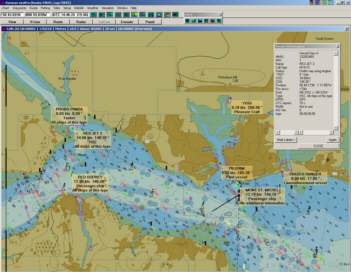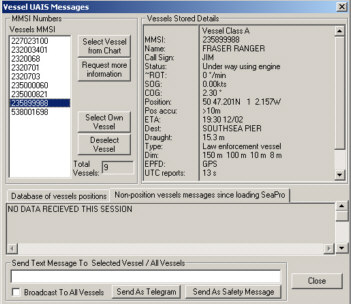|
|
AIS
was originally designed to fulfil a need for vessels to know
the location and navigational parameters of other vessels
for collision avoidance.
The transponder itself only comes with a small display which
typically gives numeric details of other vessels identification,
position, course and heading.
seaPro AIS enables this data to be shown visually at a low cost.
AIS is now finding additional uses in security and commercial
applications.
|
|
The
minimum display requirements for AIS do very little to improve the safety of vessels
from the bridge officers perspective. AIS becomes a lot more beneficial
in helping to prevent collision when the targets are plotted on
an electronic charting system such as seaPro.
For smaller vessels, the AIS module in conjunction
with a lower AIS receive only unit (such as the AI3000), gives the smaller
vessel vital information about the movement of larger vessels.
Besides the navigational benefits, seaPro and AIS can be used to show positions of passenger vessels, in harbor/Traffic control, cargo location etc. On the seaPro plus version the AIS information get be sent across the internet to different viewing stations or for combining the data from multiple receivers.
AIS receive only functions are standard in seaPro standard and above. Support for transmitting functions is available as an option. |
|
|
Set
up vessel voyage information via a simple user interface(Class A transponders). |
|
Supports sending
and receiving of messages |
|
Closest
point of approach (CPA) and time to CPA display for
selected targets. Includes ability to set CPA minimum distance from vessel. |
| |
|
| |
|
|



